Lead Leakage of Pb-Based Perovskite Solar Cells
Abstract
:1. Introduction
2. Mechanism of Lead Leakage from Pb-Based Perovskite
3. Encapsulation
4. Chemical Adsorption
5. Lead-Free Perovskite Solar Cells
6. Conclusions and Outlook
Author Contributions
Funding
Institutional Review Board Statement
Informed Consent Statement
Data Availability Statement
Conflicts of Interest
References
- Seigo, I. Research Update: Overview of progress about efficiency and stability on perovskite solar cells. APL Mater. 2016, 4, 91504. [Google Scholar]
- Krishna, B.G.; Sundar Ghosh, D.; Tiwari, S. Progress in ambient air-processed perovskite solar cells: Insights into processing techniques and stability assessment. Sol. Energy 2021, 224, 1369–1395. [Google Scholar] [CrossRef]
- Elumalai, N.; Mahmud, M.; Wang, D.; Uddin, A. Perovskite Solar Cells: Progress and Advancements. Energies 2016, 9, 861. [Google Scholar] [CrossRef]
- Wu, T.; Qin, Z.; Wang, Y.; Wu, Y.; Chen, W.; Zhang, S.; Cai, M.; Dai, S.; Zhang, J.; Liu, J.; et al. The Main Progress of Perovskite Solar Cells in 2020-2021. Nano Micro Lett. 2021, 13, 152. [Google Scholar] [CrossRef]
- Park, N.-G. Perovskite solar cells: An emerging photovoltaic technology. Mater. Today 2015, 18, 65–72. [Google Scholar] [CrossRef]
- Shai, X.-X.; Li, D.; Liu, S.-S.; Li, H.; Wang, M.-K. Advances and Developments in Perovskite Materials for Solar Cell Applications. Acta Phys. Chim. Sin. 2016, 32, 2159–2170. [Google Scholar] [CrossRef]
- Gao, Y.; Hu, Y.; Yao, C.; Zhang, S. Recent Advances in Lead-Safe Perovskite Solar Cells. Adv. Funct. Mater. 2022, 32, 2208225. [Google Scholar] [CrossRef]
- Fang, Z.; Zeng, Q.; Zuo, C.; Zhang, L.; Xiao, H.; Cheng, M.; Hao, F.; Bao, Q.; Zhang, L.; Yuan, Y.; et al. Perovskite-based tandem solar cells. Sci. Bull. 2021, 66, 621–636. [Google Scholar] [CrossRef]
- Qarony, W.; Hossain, M.I.; Salleo, A.; Knipp, D.; Tsang, Y.H. Rough versus planar interfaces: How to maximize the short circuit current of perovskite single and tandem solar cells. Mater. Today Energy 2019, 11, 106–113. [Google Scholar] [CrossRef]
- Torabi, N.; Behjat, A.; Zhou, Y.; Docampo, P.; Stoddard, R.J.; Hillhouse, H.W.; Ameri, T. Progress and challenges in perovskite photovoltaics from single- to multi-junction cells. Mater. Today Energy 2019, 12, 70–94. [Google Scholar] [CrossRef]
- Jin, X.; Yang, Y.; Zhao, T.; Wu, X.; Liu, B.; Han, M.; Chen, W.; Chen, T.; Hu, J.-S.; Jiang, Y. Mitigating Potential Lead Leakage Risk of Perovskite Solar Cells by Device Architecture Engineering from Exterior to Interior. ACS Energy Lett. 2022, 7, 3618–3636. [Google Scholar] [CrossRef]
- Assadi, M.K.; Bakhoda, S.; Saidur, R.; Hanaei, H. Recent progress in perovskite solar cells. Renew. Sustain. Energy Rev. 2018, 81, 2812–2822. [Google Scholar] [CrossRef]
- Heo, J.H.; Im, S.H. CH3 NH3 PbBr3 -CH3 NH3 PbI3 Perovskite-Perovskite Tandem Solar Cells with Exceeding 2.2 V Open Circuit Voltage. Adv. Mater. 2016, 28, 5121–5125. [Google Scholar] [CrossRef]
- Basumatary, P.; Agarwal, P. A short review on progress in perovskite solar cells. Mater. Res. Bull. 2022, 149, 111700. [Google Scholar] [CrossRef]
- Poespawati, N.R.; Sulistianto, J.; Abuzairi, T.; Purnamaningsih, R.W.; Mehta, V. Performance and Stability Comparison of Low-Cost Mixed Halide Perovskite Solar Cells: CH3NH3PbI3-xClx and CH3NH3PbI3-xSCNx. Int. J. Photoenergy 2020, 2020, 8827917. [Google Scholar] [CrossRef]
- Hong, Q.-M.; Xu, R.-P.; Jin, T.-Y.; Tang, J.-X.; Li, Y.-Q. Unraveling the light-induced degradation mechanism of CH3NH3PbI3 perovskite films. Org. Electron. 2019, 67, 19–25. [Google Scholar] [CrossRef]
- Ren, M.; Qian, X.; Chen, Y.; Wang, T.; Zhao, Y. Potential lead toxicity and leakage issues on lead halide perovskite photovoltaics. J. Hazard. Mater. 2022, 426, 127848. [Google Scholar] [CrossRef]
- Kumar, A.; Kumar, A.; Cabral-Pinto, M.M.S.; Chaturvedi, A.K.; Shabnam, A.A.; Subrahmanyam, G.; Mondal, R.; Gupta, D.K.; Malyan, S.K.; Kumar, S.S.; et al. Lead Toxicity: Health Hazards, Influence on Food Chain, and Sustainable Remediation Approaches. Int. J. Environ. Res. Public Health 2020, 17, 2179. [Google Scholar] [CrossRef]
- Ravi, V.K.; Mondal, B.; Nawale, V.V.; Nag, A. Don’t Let the Lead Out: New Material Chemistry Approaches for Sustainable Lead Halide Perovskite Solar Cells. ACS Omega 2020, 5, 29631–29641. [Google Scholar] [CrossRef]
- Wan, J.; Yu, X.; Zou, J.; Li, K.; Chen, L.; Peng, Y.; Cheng, Y.-B. Lead contamination analysis of perovskite modules under simulated working conditions. Sol. Energy 2021, 226, 85–91. [Google Scholar] [CrossRef]
- Luo, H.; Li, P.; Ma, J.; Han, L.; Zhang, Y.; Song, Y. Sustainable Pb Management in Perovskite Solar Cells toward Eco-Friendly Development. Adv. Energy Mater. 2022, 12, 2201242. [Google Scholar] [CrossRef]
- Babayigit, A.; Duy Thanh, D.; Ethirajan, A.; Manca, J.; Muller, M.; Boyen, H.G.; Conings, B. Assessing the toxicity of Pb- and Sn-based perovskite solar cells in model organism Danio rerio. Sci. Rep. 2016, 6, 18721. [Google Scholar] [CrossRef]
- Banna, H.U.; Anjum, A.; Biswas, S.; Mondal, V.; Siddique, A.E.; Roy, A.K.; Nikkon, F.; Haque, A.; Himeno, S.; Salam, K.A.; et al. Parental Lead Exposure Promotes Neurobehavioral Disorders and Hepatic Dysfunction in Mouse Offspring. Biol. Trace Elem. Res. 2022, 200, 1171–1180. [Google Scholar] [CrossRef] [PubMed]
- Lee, S.W.; Bae, S.; Kim, D.; Lee, H.S. Historical Analysis of High-Efficiency, Large-Area Solar Cells: Toward Upscaling of Perovskite Solar Cells. Adv. Mater. 2020, 32, e2002202. [Google Scholar] [CrossRef] [PubMed]
- Ono, L.K.; Qi, Y.; Liu, S. Progress toward Stable Lead Halide Perovskite Solar Cells. Joule 2018, 2, 1961–1990. [Google Scholar] [CrossRef]
- Aslan, E.; Ates Turkmen, T.; Alturk, E. High stability perovskite solar cells under ambient conditions. IET Renew. Power Gener. 2020, 14, 3160–3163. [Google Scholar] [CrossRef]
- Wang, K.; Huo, J.; Cao, L.; Yang, P.; Muller-Buschbaum, P.; Tong, Y.; Wang, H. Fully Methylammonium-Free Stable Formamidinium Lead Iodide Perovskite Solar Cells Processed under Humid Air Conditions. ACS Appl. Mater. Interfaces 2023, 15, 13353–13362. [Google Scholar] [CrossRef]
- Ma, L.; Guo, D.; Li, M.; Wang, C.; Zhou, Z.; Zhao, X.; Zhang, F.; Ao, Z.; Nie, Z. Temperature-Dependent Thermal Decomposition Pathway of Organic–Inorganic Halide Perovskite Materials. Chem. Mater. 2019, 31, 8515–8522. [Google Scholar] [CrossRef]
- Hailegnaw, B.; Kirmayer, S.; Edri, E.; Hodes, G.; Cahen, D. Rain on Methylammonium Lead Iodide Based Perovskites: Possible Environmental Effects of Perovskite Solar Cells. J. Phys. Chem. Lett. 2015, 6, 1543–1547. [Google Scholar] [CrossRef]
- Burwig, T.; Heinze, K.; Pistor, P. Thermal decomposition kinetics of FAPbI3 thin films. Phys. Rev. Mater. 2022, 6, 065404. [Google Scholar] [CrossRef]
- Conings, B.; Babayigit, A.; Boyen, H.-G. Fire Safety of Lead Halide Perovskite Photovoltaics. ACS Energy Lett. 2019, 4, 873–878. [Google Scholar] [CrossRef]
- Boyd, C.C.; Cheacharoen, R.; Leijtens, T.; McGehee, M.D. Understanding Degradation Mechanisms and Improving Stability of Perovskite Photovoltaics. Chem. Rev. 2019, 119, 3418–3451. [Google Scholar] [CrossRef] [PubMed]
- Xudong, G.; Guangda, N.; Liduo, W. Chemical Stability Issue and Its Research Process of Perovskite Solar Cells with High Efficiency. Chin. J. Chem. 2015, 73, 211. [Google Scholar]
- Goetz, K.P.; Taylor, A.D.; Hofstetter, Y.J.; Vaynzof, Y. Sustainability in Perovskite Solar Cells. ACS Appl. Mater. Interfaces 2021, 13, 1–17. [Google Scholar] [CrossRef] [PubMed]
- Cheng, Y.; Yang, Q.-D.; Ding, L. Encapsulation for perovskite solar cells. Sci. Bull. 2021, 66, 100–102. [Google Scholar] [CrossRef] [PubMed]
- Seethamraju, S.; Ramamurthy, P.C.; Madras, G. Encapsulation for Improving the Efficiencies of Solar Cells. Mater. Process. Sol. Fuel Prod. 2014, 174, 23–40. [Google Scholar]
- Jing, J.; Chen, S.; Zhang, J. Investigation of UV aging influences on the crystallization of ethylene-vinyl acetate copolymer via successive self-nucleation and annealing treatment. J. Polym. Res. 2010, 17, 827–836. [Google Scholar]
- El Amrani, A.; Mahrane, A.; Moussa, F.Y.; Boukennous, Y. Solar Module Fabrication. Int. J. Photoenergy 2007, 2007, 027610. [Google Scholar] [CrossRef]
- Jiang, S.; Wang, K.; Zhang, H.; Ding, Y.; Yu, Q. Encapsulation of PV Modules Using Ethylene Vinyl Acetate Copolymer as the Encapsulant. Macromol. React. Eng. 2015, 9, 522–529. [Google Scholar] [CrossRef]
- Tucker, R.T.; Yorgensen, R.S. A review of field performance of EVA-based encapsulants. In Proceedings of the IEEE Photovoltaic Specialists Conference, New Orleans, LA, USA, 19–24 May 2002. [Google Scholar]
- Kim, H.C.; Jang, T.W.; Chae, H.J.; Choi, W.J.; Ha, M.N.; Ye, B.J.; Kim, B.G.; Jeon, M.J.; Kim, S.Y.; Hong, Y.S. Evaluation and management of lead exposure. Ann. Occup. Environ. Med. 2015, 27, 30. [Google Scholar] [CrossRef]
- Cheacharoen, R.; Boyd, C.C.; Burkhard, G.F.; Leijtens, T.; Raiford, J.A.; Bush, K.A.; Bent, S.F.; McGehee, M.D. Encapsulating perovskite solar cells to withstand damp heat and thermal cycling. Sustain. Energy Fuels 2018, 2, 2398–2406. [Google Scholar] [CrossRef]
- Fu, Z.; Xu, M.; Sheng, Y.; Yan, Z.; Meng, J.; Tong, C.; Li, D.; Wan, Z.; Ming, Y.; Mei, A. Encapsulation of Printable Mesoscopic Perovskite Solar Cells Enables High Temperature and Long-Term Outdoor Stability. Adv. Funct. Mater. 2019, 29, 1809129.1809121–1809129.1809127. [Google Scholar] [CrossRef]
- Kim, H.; Lee, J.; Kim, B.; Byun, H.R.; Kim, S.H.; Oh, H.M.; Baik, S.; Jeong, M.S. Enhanced Stability of MAPbI(3) Perovskite Solar Cells using Poly(p-chloro-xylylene) Encapsulation. Sci. Rep. 2019, 9, 15461. [Google Scholar] [CrossRef]
- Shi, L.; Bucknall, M.P.; Young, T.L.; Zhang, M.; Hu, L.; Bing, J.; Lee, D.S.; Kim, J.; Wu, T.; Takamure, N.; et al. Gas chromatography-mass spectrometry analyses of encapsulated stable perovskite solar cells. Science 2020, 368, eaba2412. [Google Scholar] [CrossRef] [PubMed]
- Yin, J.; Cui, J.; Zhou, H.; Cui, S.; Wang, C.; Guo, J.; Wei, J.; Zhang, X. Encapsulation of UV Glue, Hydrophobicity of Binder and Carbon Electrode Enhance the Stability of Organic–Inorganic Hybrid Perovskite Solar Cells up to 5 Years. Energy Technol. 2020, 8, 2000513. [Google Scholar] [CrossRef]
- Liu, W.; Wang, Z.; Chen, Z.; Zhao, L. Thermo-initiated cationic polymerization of phosphorus-containing cycloaliphatic epoxides with tunable degradable temperature. Polym. Degrad. Stab. 2012, 97, 810–815. [Google Scholar] [CrossRef]
- Jiang, Y.; Qiu, L.; Juarez-Perez, E.J.; Ono, L.K.; Hu, Z.; Liu, Z.; Wu, Z.; Meng, L.; Wang, Q.; Qi, Y. Reduction of lead leakage from damaged lead halide perovskite solar modules using self-healing polymer-based encapsulation. Nat. Energy 2019, 4, 585–593. [Google Scholar] [CrossRef]
- Wang, X.; Dong, B.; Feng, M.; Xue, D.-J.; Wang, S.-M. Sustainable management of lead in perovskite solar cells. J. Mater. Chem. A 2022, 10, 15861–15864. [Google Scholar] [CrossRef]
- Lee, Y.I.; Jeon, N.J.; Kim, B.J.; Shim, H.; Yang, T.-Y.; Seok, S.I.; Seo, J.; Im, S.G. A Low-Temperature Thin-Film Encapsulation for Enhanced Stability of a Highly Efficient Perovskite Solar Cell. Adv. Energy Mater. 2018, 8, 1701928. [Google Scholar] [CrossRef]
- Sarkar, S.; Culp, J.H.; Whyland, J.T.; Garvan, M.; Misra, V. Encapsulation of organic solar cells with ultrathin barrier layers deposited by ozone-based atomic layer deposition. Org. Electron. 2010, 11, 1896–1900. [Google Scholar] [CrossRef]
- Park, J.S.; Chae, H.; Chung, H.K.; Lee, S.I. Thin film encapsulation for flexible AM-OLED: A review. Semicond. Sci. Technol. 2011, 26, 034001. [Google Scholar] [CrossRef]
- Zhang, Y.; Yang, Y.; Mbumba, M.T.; Akram, M.W.; Rop, E.K.; Bai, L.; Guli, M. Research Progress of Buffer Layer and Encapsulation Layer Prepared by Atomic Layer Deposition to Improve the Stability of Perovskite Solar Cells. Sol. RRL 2022, 6, 2200823. [Google Scholar] [CrossRef]
- Clark, M.D.; Jespersen, M.L.; Patel, R.J.; Leever, B.J. Ultra-thin alumina layer encapsulation of bulk heterojunction organic photovoltaics for enhanced device lifetime. Org. Electron. 2014, 15, 1–8. [Google Scholar] [CrossRef]
- Zuo, C.; Bolink, H.J.; Han, H.; Huang, J.; Cahen, D.; Ding, L. Advances in Perovskite Solar Cells. Adv. Sci. 2016, 3, 1500324. [Google Scholar] [CrossRef]
- Bag, M.; Banerjee, S.; Faust, R.; Venkataraman, D. Self-healing polymer sealant for encapsulating flexible solar cells. Sol. Energy Mater. Sol. Cells 2016, 145, 418–422. [Google Scholar] [CrossRef]
- Yu, Y.; Zhang, F.; Yu, H. Self-healing perovskite solar cells. Sol. Energy 2020, 209, 408–414. [Google Scholar] [CrossRef]
- Chen, S.; Deng, Y.; Gu, H.; Xu, S.; Wang, S.; Yu, Z.; Blum, V.; Huang, J. Trapping lead in perovskite solar modules with abundant and low-cost cation-exchange resins. Nat. Energy 2020, 5, 1003–1011. [Google Scholar] [CrossRef]
- Shao, Y.; Xiao, Z.; Bi, C.; Yuan, Y.; Huang, J. Origin and elimination of photocurrent hysteresis by fullerene passivation in CH3NH3PbI3 planar heterojunction solar cells. Nat. Commun. 2014, 5, 5784. [Google Scholar] [CrossRef]
- Wang, Q.; Lin, Z.; Su, J.; Xu, Y.; Guo, X.; Li, Y.; Zhang, M.; Zhang, J.; Chang, J.; Hao, Y. Dithiol surface treatment towards improved charge transfer dynamic and reduced lead leakage in lead halide perovskite solar cells. EcoMat 2022, 4, e12185. [Google Scholar] [CrossRef]
- Tewari, P.K.; Singh, A.K. Preconcentration of lead with Amberlite XAD-2 and Amberlite XAD-7 based chelating resins for its determination by flame atomic absorption spectrometry. Talanta 2002, 56, 735–744. [Google Scholar] [CrossRef]
- Tharanitharan, V.; Srinivasan, K. Removal of Pb(II) from aqueous solutions by using dioctyl sodium sulphosuccinate-EDTA modified Amberlite XAD-7HP resin. Indian J. Chem. Technol. 2009, 16, 417–425. [Google Scholar]
- Li, X.; Zhang, F.; He, H.; Berry, J.J.; Zhu, K.; Xu, T. On-device lead sequestration for perovskite solar cells. Nature 2020, 578, 555–558. [Google Scholar] [CrossRef] [PubMed]
- Li, X.; Zhang, F.; Wang, J.; Tong, J.; Xu, T.; Zhu, K. On-device lead-absorbing tapes for sustainable perovskite solar cells. Nat. Sustain. 2021, 4, 1038–1041. [Google Scholar] [CrossRef]
- Chen, J.; Li, S.; Ma, T.; Wu, D.; Zhao, Y.; Wang, C.; Zhao, D.; Li, X. Managing Lead Leakage in Efficient Perovskite Solar Cells with Phosphate Interlayers. Adv. Mater. Interfaces 2022, 9, 2200570. [Google Scholar] [CrossRef]
- Dou, J.; Bai, Y.; Chen, Q. Challenges of lead leakage in perovskite solar cells. Mater. Chem. Front. 2022, 6, 2779–2789. [Google Scholar] [CrossRef]
- Giustino, F.; Snaith, H.J. Toward Lead-Free Perovskite Solar Cells. ACS Energy Lett. 2016, 1, 1233–1240. [Google Scholar] [CrossRef]
- Wu, T.; Cui, D.; Liu, X.; Luo, X.; Su, H.; Segawa, H.; Zhang, Y.; Wang, Y.; Han, L. Additive Engineering toward High-Performance Tin Perovskite Solar Cells. Sol. RRL 2021, 5, 2100034. [Google Scholar] [CrossRef]
- Ke, W.; Kanatzidis, M.G. Prospects for low-toxicity lead-free perovskite solar cells. Nat. Commun. 2019, 10, 965. [Google Scholar] [CrossRef]
- Schileo, G.; Grancini, G. Lead or no lead? Availability, toxicity, sustainability and environmental impact of lead-free perovskite solar cells. J. Mater. Chem. C 2021, 9, 67–76. [Google Scholar] [CrossRef]
- Hussain, I.; Tran, H.P.; Jaksik, J.; Moore, J.; Islam, N.; Uddin, M.J. Functional materials, device architecture, and flexibility of perovskite solar cell. Emergent Mater. 2018, 1, 133–154. [Google Scholar] [CrossRef]
- Yang, S.; Fu, W.; Zhang, Z.; Chen, H.; Li, C.; Mater, J. Recent advances in perovskite solar cells: Efficiency, stability and lead-free perovskite. J. Mater. Chem. A 2017, 5, 11462–11482. [Google Scholar] [CrossRef]
- Ke, W.; Stoumpos, C.C.; Kanatzidis, M.G. “Unleaded” Perovskites: Status Quo and Future Prospects of Tin-Based Perovskite Solar Cells. Adv. Mater. 2019, 31, e1803230. [Google Scholar] [CrossRef] [PubMed]
- Abate, A. Stable Tin-Based Perovskite Solar Cells. ACS Energy Lett. 2023, 8, 1896–1899. [Google Scholar] [CrossRef] [PubMed]
- Hoshi, H.; Shigeeda, N.; Dai, T. Improved oxidation stability of tin iodide cubic perovskite treated by 5-ammonium valeric acid iodide. Mater. Lett. 2016, 183, 391–393. [Google Scholar] [CrossRef]
- Stoumpos, C.C.; Malliakas, C.D.; Kanatzidis, M.G. Semiconducting tin and lead iodide perovskites with organic cations: Phase transitions, high mobilities, and near-infrared photoluminescent properties. Inorg. Chem. A Res. J. That Incl. Bioinorg. Catal. Organomet. Solid State Synth. Chem. React. Dyn. 2013, 52, 9019–9038. [Google Scholar] [CrossRef]
- Meng, X.; Lin, J.; Liu, X.; He, X.; Wang, Y.; Noda, T.; Wu, T.; Yang, X.; Han, L. Highly Stable and Efficient FASnI(3) -Based Perovskite Solar Cells by Introducing Hydrogen Bonding. Adv. Mater. 2019, 31, e1903721. [Google Scholar] [CrossRef]
- Brivio, F.; Frost, J.M.; Skelton, J.M.; Jackson, A.J.; Weber, O.J.; Weller, M.T.; Goni, A.R.; Leguy, A.; Barnes, P.; Walsh, A. Lattice dynamics and vibrational spectra of the orthorhombic, tetragonal and cubic phases of methylammonium lead iodide. Phys. Rev. B 2015, 92, 144308. [Google Scholar] [CrossRef]
- Liu, M.; Pasanen, H.; Ali-Lytty, H.; Hiltunen, A.; Vivo, P. B-Site Co-Alloying with Germanium Improves the Efficiency and Stability of All-Inorganic Tin-Based Perovskite Nanocrystal Solar Cells. Angew. Chem. Int. Ed. 2020, 59, 22117–22125. [Google Scholar] [CrossRef]
- Azhari, A.W.; Then, F.S.X.; Halin, D.S.C.; Sepeai, S.; Ludin, N.A. Tin and germanium substitution in lead free perovskite solar cell: Current status and future trends. In IOP Conference Series: Materials Science and Engineering; IOP Publishing: Bristol, UK, 2020. [Google Scholar]
- Krishnamoorthy, T.; Ding, H.; Yan, C.; Leong, W.L.; Baikie, T.; Zhang, Z.; Sherburne, M.; Li, S.; Asta, M.; Mathews, N.; et al. Lead-free germanium iodide perovskite materials for photovoltaic applications. J. Mater. Chem. A Mater. Energy Sustain. 2015, 3, 23829–23832. [Google Scholar] [CrossRef]
- Chiara, R.; Morana, M.; Malavasi, L. Germanium-Based Halide Perovskites: Materials, Properties, and Applications. ChemPlusChem 2021, 86, 879–888. [Google Scholar] [CrossRef]
- Liu, Y.; Nag, A.; Manna, L.; Xia, Z. Lead-Free Double Perovskite Cs2 AgInCl6. Angew. Chem. 2021, 60, 11592–11603. [Google Scholar] [CrossRef] [PubMed]
- Dave, K.; Fang, M.H.; Bao, Z.; Fu, H.T.; Liu, R.S. Recent Developments in Lead-Free Double Perovskites: Structure, Doping, and Applications. Chem. Asian J. 2020, 15, 242–252. [Google Scholar] [CrossRef] [PubMed]
- Wu, C.; Zhang, Q.; Liu, Y.; Luo, W.; Guo, X.; Huang, Z.; Ting, H.; Sun, W.; Zhong, X.; Wei, S.; et al. The Dawn of Lead-Free Perovskite Solar Cell: Highly Stable Double Perovskite Cs2AgBiBr6 Film. Adv. Sci. 2018, 5, 1700759. [Google Scholar] [CrossRef] [PubMed]
- Fan, E.; Liu, M.; Yang, K.; Jiang, S.; Li, B.; Zhao, D.; Guo, Y.; Zhang, Y.; Zhang, P.; Zuo, C.; et al. One-Step Gas-Solid-Phase Diffusion-Induced Elemental Reaction for Bandgap-Tunable Cu(a)Ag(m1)Bi(m2)I(n)/CuI Thin Film Solar Cells. Nano Micro Lett. 2023, 15, 58. [Google Scholar] [CrossRef]
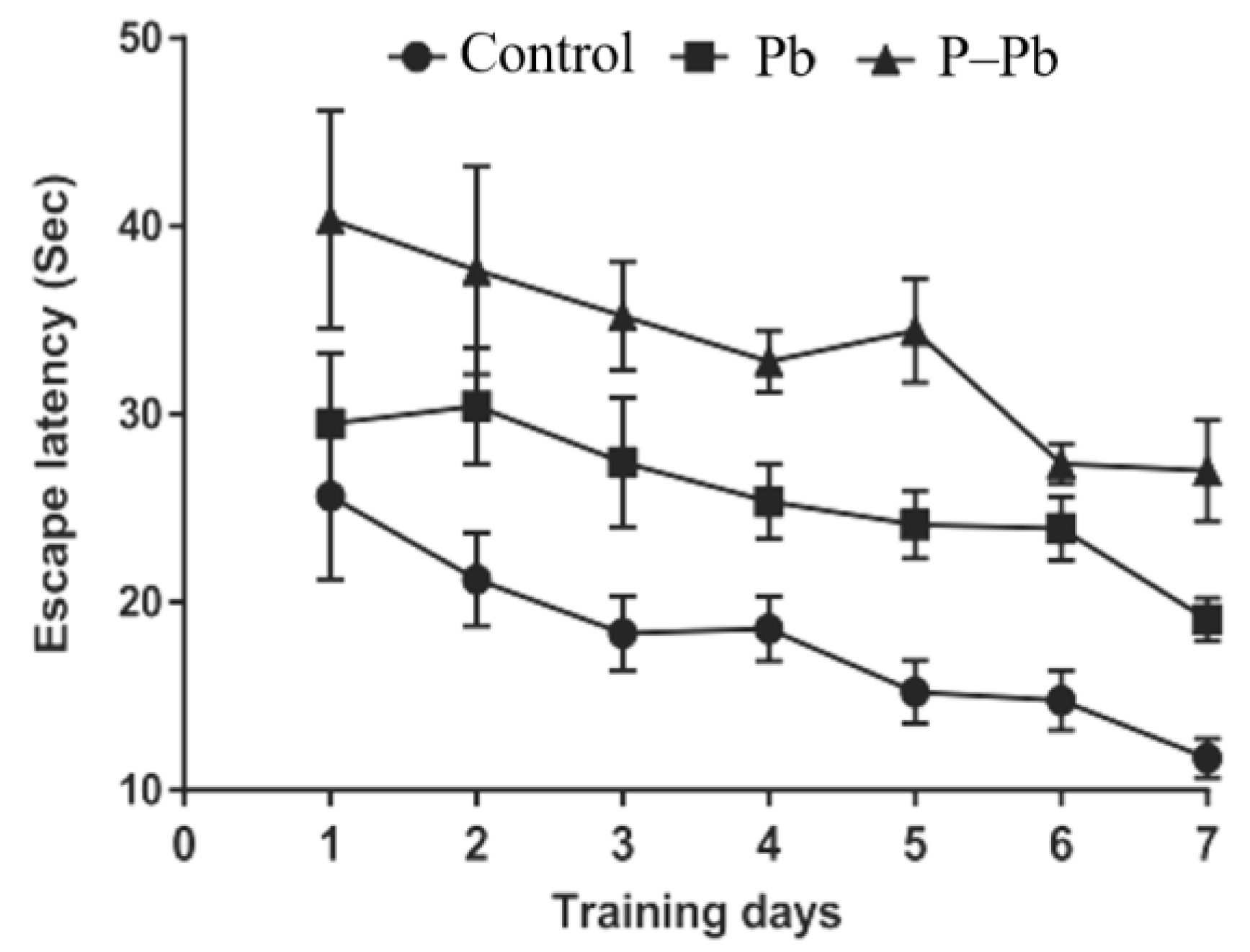
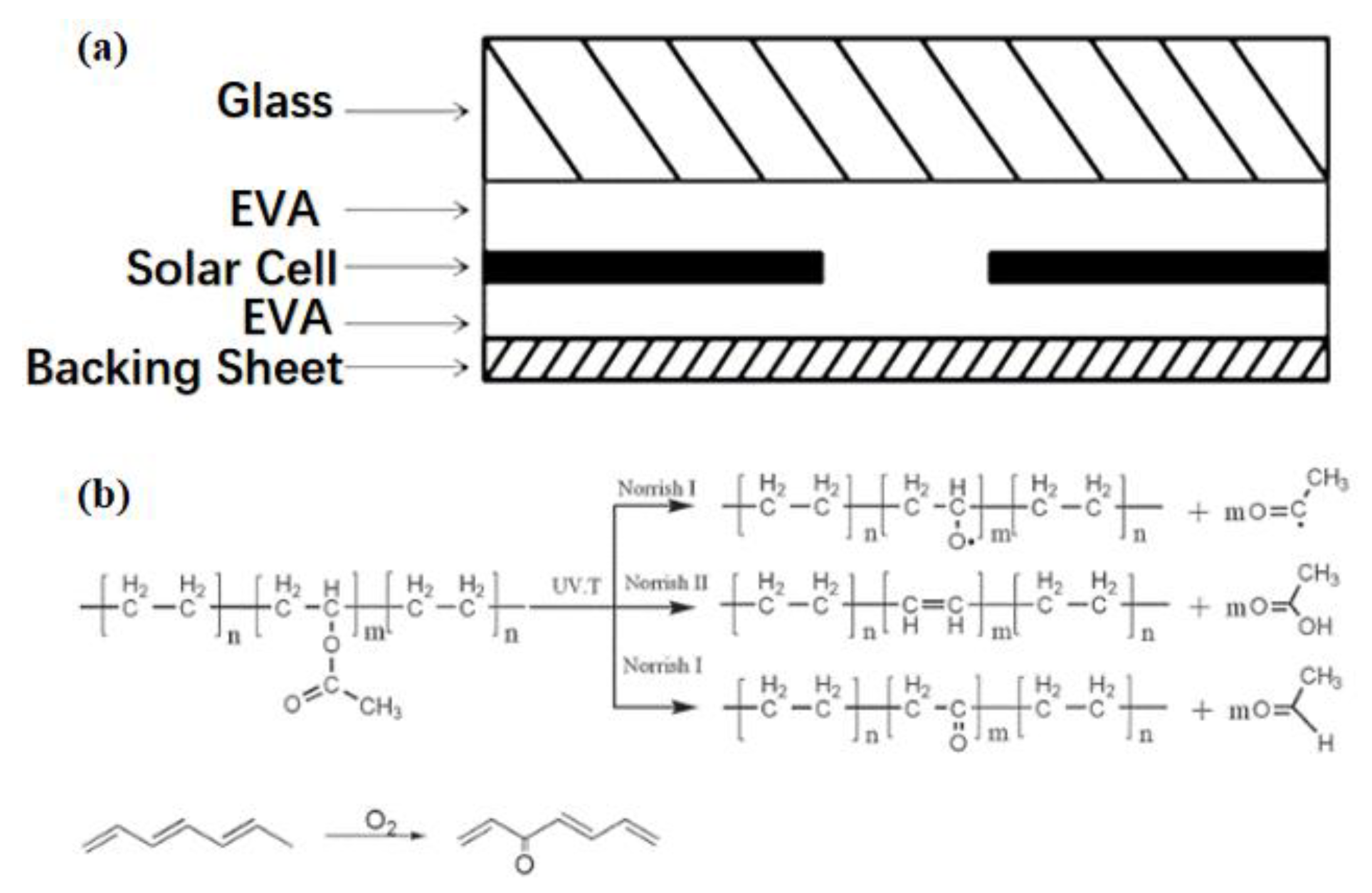

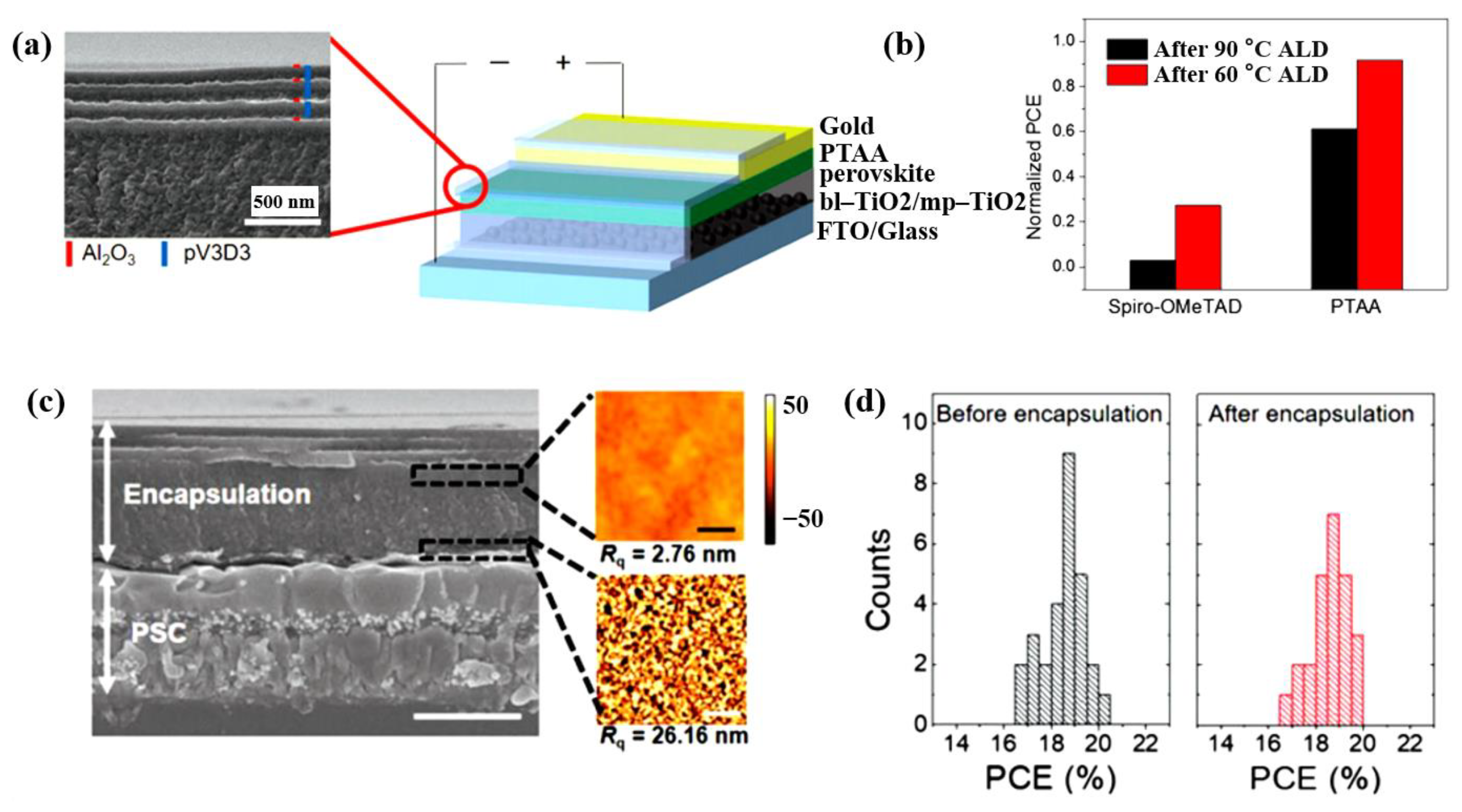

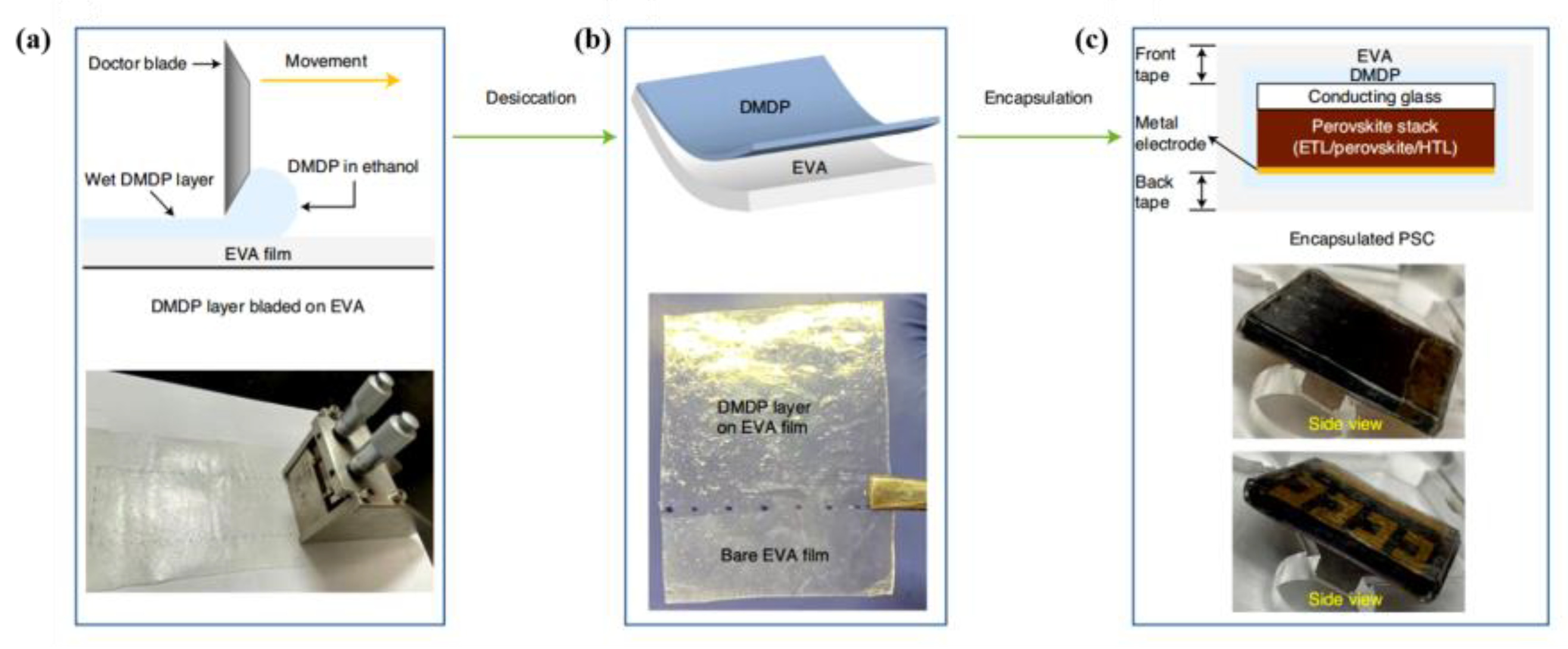

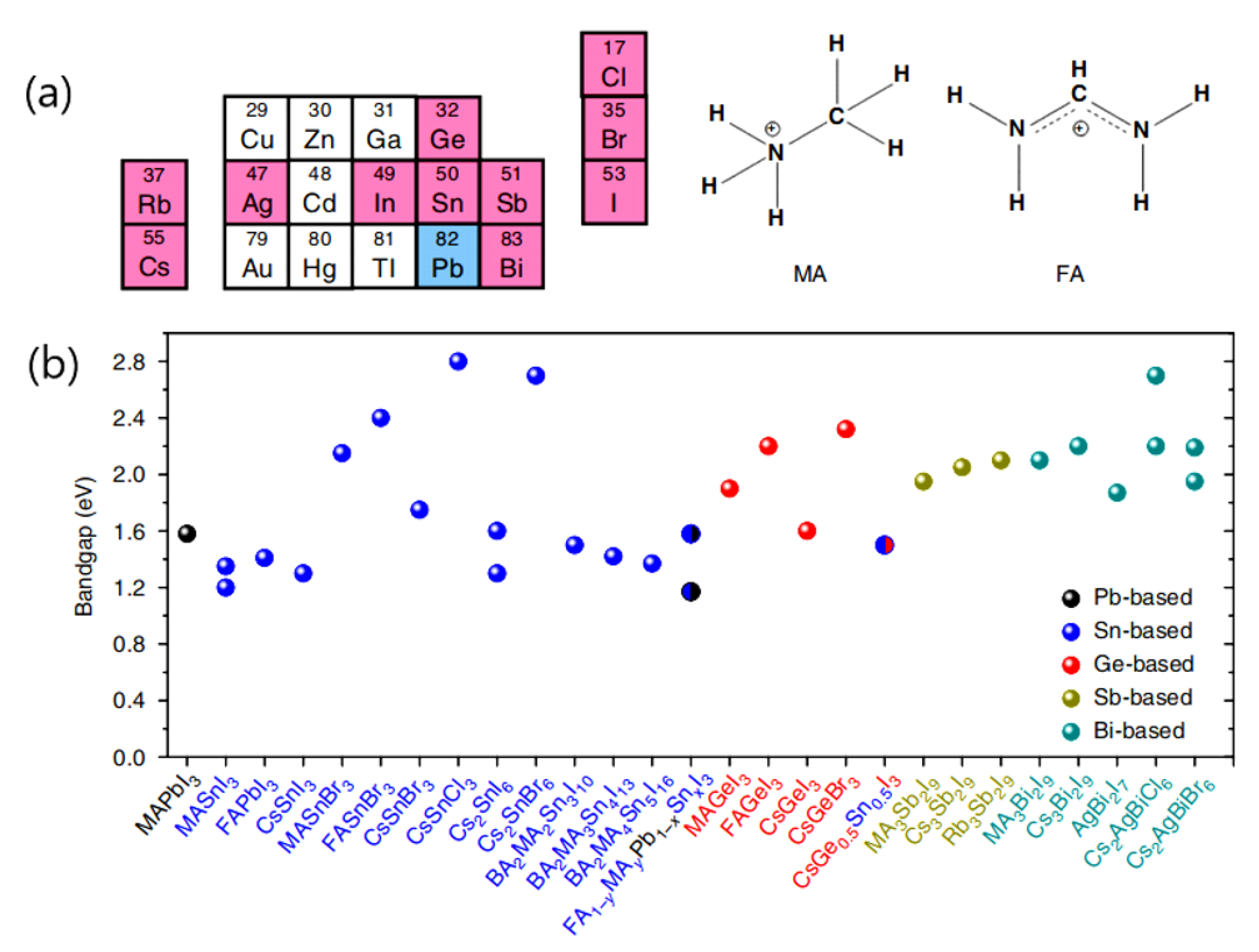

| Encapsulation | Chemical Adsorption | |
|---|---|---|
| Cost | High | Low |
| Whether mechanical strength can be improved | √ | × |
| Whether the amount of lead leaking into the environment can be reduced | × | √ |
Disclaimer/Publisher’s Note: The statements, opinions and data contained in all publications are solely those of the individual author(s) and contributor(s) and not of MDPI and/or the editor(s). MDPI and/or the editor(s) disclaim responsibility for any injury to people or property resulting from any ideas, methods, instructions or products referred to in the content. |
© 2023 by the authors. Licensee MDPI, Basel, Switzerland. This article is an open access article distributed under the terms and conditions of the Creative Commons Attribution (CC BY) license (https://creativecommons.org/licenses/by/4.0/).
Share and Cite
Ma, K.; Li, X.; Yang, F.; Liu, H. Lead Leakage of Pb-Based Perovskite Solar Cells. Coatings 2023, 13, 1009. https://doi.org/10.3390/coatings13061009
Ma K, Li X, Yang F, Liu H. Lead Leakage of Pb-Based Perovskite Solar Cells. Coatings. 2023; 13(6):1009. https://doi.org/10.3390/coatings13061009
Chicago/Turabian StyleMa, Kai, Xiaofang Li, Feng Yang, and Hairui Liu. 2023. "Lead Leakage of Pb-Based Perovskite Solar Cells" Coatings 13, no. 6: 1009. https://doi.org/10.3390/coatings13061009





